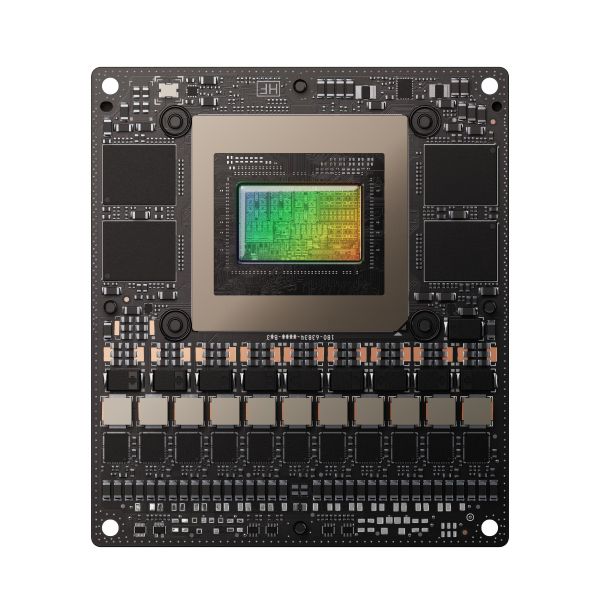NVIDIA Jetson Thor Module
SKU
TEMP-ACC-0675
Brand Reward Points
0
₹287,910.00 ₹339,733.80
Pre Order
Categories: Product Development Board Brand NVIDIA Development Boards NVIDIA NVIDIA Jetson Developer Boards
Topic: Topic
Product Description
The NVIDIA Jetson T5000™ module gives you the highest level of performance for physical Al and robotics. It delivers up to 2070 FP4 TFLOPS of Al compute and 128 GB of memory with power configurable between 40 W and 130 W. Compared to AGX Orin™, it delivers over 7.5x higher Al compute than NVIDIA AGX Orin", with 3.5x better energy efficiency.
This system-on-module (SOM) features an NVIDIA Blackwell architecture GPU with a transformer engine and Multi-Instance GPU (MIG) support to effortlessly run the latest generative Al models. NVIDIA Jetson Thor™ accelerates low-latency, real-time multi-sensor applications with a 14-core Arm Neoverse-V3AE CPU, 4x 25 GbE networking, and extensive I/O options for sensor fusion. It also includes a suite of accelerators, including a third-generation Programmable Vision Accelerator (PVA), dual encoders and decoders, an optical flow accelerator, and more.
Jetson Thor belongs to a new class of robotic computers, architected from the ground up to power next-generation physical Al applications. It supports a wide range of generative Al models, from Vision Language Action (VLA) models like NVIDIA Isaac™ GROOT for humanoids to all popular LLMs and VLMs. To deliver a seamless cloud-to-edge experience, Jetson Thor runs the NVIDIA Al software stack for physical Al applications, including NVIDIA Isaac for robotics, NVIDIA Metropolis for visual agentic Al, and NVIDIA Holoscan for sensor processing. You can also build Al agents at the edge using NVIDIA agentic Al workflows like Video Search and Summarization (VSS).
Our ecosystem of partners offers all the carrier boards, design services, cameras, and other sensors you need, as well as additional Al and system software. This lets you accelerate solution development in industries ranging from robotics and smart spaces to retail, industrial, medical, and more.
The Jetson Thor module gives you production-ready performance, massive Al compute, and sensor capabilities for physical Al applications in a compact form factor. This makes it the ideal platform for developers looking to unlock new possibilities for humanoid robotics and other physical Al applications.
Key Features
- NVIDIA Jetson T5000 Module
- 2070 FP4 TFLOPS AI Compute powered by Blackwell GPU
- 4-core ARM® Neoverse® CPU
- 128 GB LPDDR5X Memory
Explore full Jetson Thor documentation and resources — visit NVIDIA Developer.
Technical Specifications
| Category | Specification |
| Product | NVIDIA Jetson T5000 |
| AI Performance | 2070 TFLOPS (FP4—sparse) |
| GPU | 2560-core NVIDIA Blackwell architecture GPU with 96 fifth-gen Tensor Cores Multi-Instance GPU with 10 TPCs |
| GPU Max Frequency | 1.57 GHz |
| CPU | 14-core Arm® Neoverse®-V3AE 64-bit CPU; 64 KB I-Cache, 64 KB D-Cache; 1 MB L2 Cache per core; 16 MB shared system L3 cache |
| CPU Max Frequency | 2.6 GHz |
| Vision Accelerator | 1× PVA v3 |
| Memory | 128 GB 256-bit LPDDR5X, 273 GB/s |
| Storage | Supports NVMe through PCIe; Supports SSD through USB 3.2 |
| Video Encode | 6× 4Kp60 (H.265); 12× 4Kp30 (H.265); 24× 1080p60 (H.265); 50× 1080p30 (H.265); 48× 1080p30 (H.264); 6× 4Kp60 (H.264) |
| Video Decode | 4× 8Kp30 (H.265); 10× 4Kp60 (H.265); 22× 4Kp30 (H.265); 46× 1080p60 (H.265); 92× 1080p30 (H.265); 82× 1080p30 (H.264); 4× 4Kp60 (H.264) |
| Camera | Up to 20 cameras via HSB; Up to 6 cameras through 16× lanes MIPI CSI-2; Up to 32 cameras using virtual channels; C-PHY 2.1 (10.25 Gbps); D-PHY 2.1 (40 Gbps) |
| PCIe* | Up to 8 lanes—Gen5; Root port only—C1 (x1) and C3 (x2); Root Point or Endpoint—C2 (x1), C4 (x8), and C5 (x4) |
| USB | xHCI host controller with integrated PHY; 3× USB 3.2; 4× USB 2.0 |
| Networking | 4× 25 GbE |
| Display | 4× shared HDMI 2.1; VESA DisplayPort 1.4a—HBR2, MST |
| Other I/O | 5× I2S/2× Audio Hub (AHUB), 2× DMIS, 4× UART, 4× CAN, 3× SPI, 13× I2C, 6× PWM outputs |
| Power | 40 W–130 W |
| Mechanical | 100 mm × 87 mm; 699-pin B2B connector; Integrated Thermal Transfer Plate (TTP) with heatpipe |
| Predicted Available Time | Dec 17, 2025 |
|---|
Write Your Own Review
- Nvidia Jetson Thor T5000 Module



